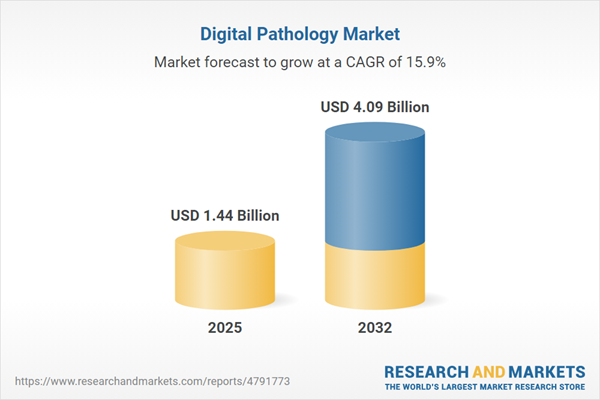Speak directly to the analyst to clarify any post sales queries you may have.
Digital pathology is redefining clinical and research operations, streamlining diagnostics and boosting precision for healthcare and life sciences. For senior decision-makers, embracing these digital strategies is critical to maintaining efficient, compliant, and future-proof organizations in a rapidly shifting healthcare landscape.
Market Snapshot: Digital Pathology Market Overview
The global digital pathology market is valued at USD 1.25 billion in 2024, projected to reach USD 1.44 billion in 2025, with anticipated growth to USD 4.09 billion by 2032. This expected 15.90% compound annual growth rate signals robust demand for digital adoption, driven by evolving research methods, diversification of clinical and research applications, and the growing need for interoperability and regulatory compliance. Regional differences, particularly in compliance frameworks and operational requirements, highlight the importance of adaptable implementation approaches. Success relies on strategic investments in technology aligned with industry trends, scalable digital infrastructure, and regulatory mandates.
Scope & Segmentation: Dimensions and Drivers
- Type: Human pathology improves diagnostic accuracy and operational agility across care systems; veterinary pathology expands translational research capacity and supports animal health management.
- Product: High-resolution scanners, advanced digital displays, and protected data storage lay the groundwork for system deployment, ensuring both new and legacy healthcare facilities achieve compliance and operational reliability.
- Services: Consulting, system integration, ongoing maintenance, and workforce training facilitate seamless digital transitions and help teams attain targeted efficiency goals.
- Software: Platforms for image management, laboratory information, and digital archiving streamline automation, enhance workflow collaboration, and support secure, scalable lab modernization.
- Application: Digital pathology platforms facilitate biomarker discovery, virtual diagnostics, pharmaceutical research, toxicology screening, and education, adding value in both clinical and R&D environments.
- End User: Academic centers, contract research organizations, diagnostic laboratories, regulators, hospitals, and pharmaceutical firms benefit from elevated transparency and process consistency.
- Regions: Strategies reflect variations in digital readiness, infrastructure maturity, and regulatory contexts, emphasizing the need for regionally tailored implementations.
- Key Companies: F. Hoffmann-La Roche Ltd., FUJIFILM Holdings Corporation, 3DHISTECH Ltd., and Aiforia Technologies PLC deliver specialized offerings addressing wide-ranging healthcare and research objectives.
Key Takeaways for Senior Decision-Makers
- Digital pathology adoption improves diagnostics and laboratory operations, strengthening organizational precision and risk mitigation activities.
- Unified digital platforms help organizations adapt workflows to evolving compliance demands and rapidly changing clinical priorities.
- Flexible operating models, underpinned by governance frameworks, enable efficient response to changing market and regulatory pressures.
- Strategically managed supplier relationships and robust procurement practices support effective and secure technology integration.
- Interoperable systems promote seamless migration between legacy and new technologies, facilitating organizational scalability and future readiness.
Tariff Impact: Navigating Procurement Challenges
International tariffs influence procurement complexity in the digital pathology ecosystem. Senior leaders can address these issues by building resilient supplier networks, using adaptive contract structures, and scheduling phased deployments that maintain project timelines, even as regulatory requirements evolve.
Methodology & Data Sources
This analysis draws on structured interviews with laboratory executives, pathologists, research leaders, and procurement professionals. Rigorous secondary research corroborates these findings, supporting a comprehensive and balanced assessment of sector trends and digital solution adoption.
Why This Report Matters
- Offers thorough performance benchmarking of key vendors across global regions and varied operational environments in the digital pathology market.
- Equips leadership with actionable recommendations tailored to digital transformation objectives and evolving business and clinical needs.
- Prepares organizations to navigate compliance and integration challenges, enhancing long-term agility in a dynamic operating environment.
Conclusion
Ongoing awareness of digital pathology trends and compliance shifts is essential for sustained operational advancement. Responsive strategy and flexible execution enable organizations to maintain resilience amid sector evolution.
Additional Product Information:
- Purchase of this report includes 1 year online access with quarterly updates.
- This report can be updated on request. Please contact our Customer Experience team using the Ask a Question widget on our website.
Table of Contents
3. Executive Summary
4. Market Overview
7. Cumulative Impact of Artificial Intelligence 2025
Companies Mentioned
The companies profiled in this Digital Pathology market report include:- F. Hoffmann-La Roche Ltd.
- FUJIFILM Holdings Corporation
- 3DHISTECH Ltd.
- Aiforia Technologies PLC
- Charles River Laboratories
- Corista LLC
- Danaher Corporation
- Deep Bio Inc.
- Epredia
- General Electric Company
- Hamamatsu Photonics K.K.
- Huron Digital Pathology
- Indica Labs
- Koninklijke Philips N.V.
- Laboratory Corporation of America Holdings
- Mikroscan Technologies, Inc.
- Motic
- Nikon Corporation
- OptraSCAN Inc.
- Pathcore Inc.
- PathPresenter Corporation
- PerkinElmer, Inc.
- Proscia, Inc.
- Quest Diagnostics Incorporated
- Sectra AB
- Visiopharm A/S
- Xybion Digital Inc.
- Olympus Corporation
- Akoya Biosciences
Table Information
| Report Attribute | Details |
|---|---|
| No. of Pages | 183 |
| Published | November 2025 |
| Forecast Period | 2025 - 2032 |
| Estimated Market Value ( USD | $ 1.44 Billion |
| Forecasted Market Value ( USD | $ 4.09 Billion |
| Compound Annual Growth Rate | 15.9% |
| Regions Covered | Global |
| No. of Companies Mentioned | 30 |









